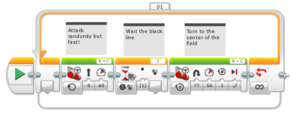Combinatorics and Sumo Robotics: Difference between revisions
No edit summary |
|||
| (2 intermediate revisions by the same user not shown) | |||
| Line 1: | Line 1: | ||
<languages /> | |||
<translate> | |||
== Introduction == | == Introduction == | ||
| Line 37: | Line 41: | ||
<gallery> | <gallery> | ||
APA_3teams.pdf | APA_3teams.pdf | 3 teams | ||
APA_4teams.pdf | APA_4teams.pdf | 4 teams | ||
APA_5teams.pdf | APA_5teams.pdf | 5 teams | ||
APA_6teams.pdf | APA_6teams.pdf | 6 teams | ||
APA_7teams.pdf | APA_7teams.pdf | 7 teams | ||
APA_8teams.pdf | APA_8teams.pdf | 8 teams | ||
</gallery> | </gallery> | ||
| Line 52: | Line 56: | ||
* Does all—play—play have more or less matches than double elimination? | * Does all—play—play have more or less matches than double elimination? | ||
* Is all—play—play tournament more fair than single elimination or double elimination? | * Is all—play—play tournament more fair than single elimination or double elimination? | ||
Back to [[Mahtavaa Matematiikkaa 2020]] | |||
</translate> | |||
[[File:Mahtavaa matematiikkaa.png|thumb]] | |||
Latest revision as of 19:43, 25 October 2020
<languages />
<translate>
Introduction
The sumo competition is very interesting, and in its most basic form is rather easy to conduct. Use some time to design and build the robots, then code it using a very simple line-detection algorithm in a loop, and finally have a tournament.
The mathematics is included into the combinatoric problem how to organize the competition.
Theory
Sumo Rules for Beginners

The field can be marked on a floor using black tape, or you might cut it from a plywood. The wooden field is better, because it is easier to note the winner.
You can attach some attacking tools to the robot, the more efficiently push the opponent from the field. The code shown here is very simple, and you need to adjust the parameters according to your robot.
Below is given three different methods to have a competition. Print the brackets and fill by hand.
Elimination Tournament
You cannot win if you lose.
Write the name of the teams on the horizontal lines.
-
Caption1
Double Elimination Tournament
You cannot win if you lose twise.
All—Play—All Tournament
The player with most wins wins.
-
3 teams
-
4 teams
-
5 teams
-
6 teams
-
7 teams
-
8 teams
Exercises
- Organize a sumo tournament
- Count the number of matches in different tournaments. Can you see how elimination and double elimination differ each other?
- Check that the tournament brackets are fair
- Does all—play—play have more or less matches than double elimination?
- Is all—play—play tournament more fair than single elimination or double elimination?
Back to Mahtavaa Matematiikkaa 2020
</translate>







